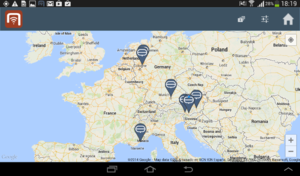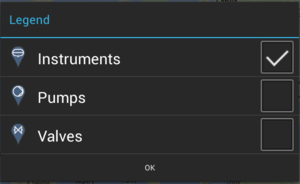Difference between revisions of "Map View (outdated)"
m (Text replacement - "{{VersionAndroid" to "{{Version/Android") |
|||
| Line 1: | Line 1: | ||
Map View is the view that displays Points of Interests (POI’s) on a base map. | Map View is the view that displays Points of Interests (POI’s) on a base map. | ||
| + | |||
| + | == Prerequisites == | ||
| + | [[File:UI_Android_Google_Play_Services_Missing.png|thumb|alt=Google Play Services Missing|Google Play Services Missing]] | ||
| + | In the map view, {{UBIK}} integrates [https://developers.google.com/maps/documentation/android/ Google Maps] which requires [https://developers.google.com/android/guides/overview Google Play Services]. If the latter is not available on a device, {{UBIK}} can still be installed and most of its features will still function. However, the map view will not be accessible and a notification will be shown in that case. | ||
| + | {{Version/AndroidSince|2.4.5}} | ||
== Visualization == | == Visualization == | ||
| Line 66: | Line 71: | ||
A user can rotate the map by placing two fingers on the map and applying a rotate motion. | A user can rotate the map by placing two fingers on the map and applying a rotate motion. | ||
| − | [[Category:Android]] | + | [[Category:Android|Map View]] |
Revision as of 13:24, 8 June 2015
Map View is the view that displays Points of Interests (POI’s) on a base map.
Contents
Prerequisites
In the map view, UBIK® integrates Google Maps which requires Google Play Services. If the latter is not available on a device, UBIK® can still be installed and most of its features will still function. However, the map view will not be accessible and a notification will be shown in that case.
Visualization
A typical Map view consists of the base map, top map menu, bottom navigation menu, location button, zoom buttons.
Base map
The base map typically displays all the Geo content according to the rules described below. Different objects are represented by different icons on the map.
The rules regarding what content should be displayed are as follows:
- The object has to be a Geo content
- If a POI group is currently open/active, objects that are shown are:
- POI group items that belong to the current group;
- Objects that are not POI group items;
- If a map layer is currently selected, objects that are shown are:
- Items of the current Map Layer;
- Objects that are not map layer items.
- If there is an object as the context of the map view (e.g. User opens a Geo content in the map), that object is displayed in addition to whatever else is.
| Before Version 2.4.3 - Android objects had to be in the Infrastructure in order to be shown at all. |
Home button
Pressing this button, opens a dialog box asking the user to specify where to navigate next. The user has the option of navigating to either the start menu, settings or the information view. To go back the map view without any selection the user must press the back button in the bottom navigation menu
Map settings button
By pressing this button, the user can change between Map (default setting), Satellite and Hybrid views. The map view changes the base map after clicking one of the radio buttons.
Map layers button
The Geo content can be configured on the server side to belong to a certain layer. By pressing this button, a dialog will be displayed to the user, containing all the available layers. By checking off the layers in the dialog box, the user is able to decide to view the Geo content belonging to the checked layers.
Location button
This button enables the user to zoom into the current position of the mobile device.
Zoom buttons
The + button zooms into the map, the - button zooms out of the map.
Interaction
POI dialog
By clicking on an icon on the map, a POI dialog will be displayed.
Map gestures
Zoom
- Double tap to increase the zoom level by 1 (zoom in).
- Two finger tap to decrease the zoom level by 1 (zoom out).
- Two finger pinch/stretch.
- One finger zooming by double tapping but not releasing on the second tap and then sliding the finger up or down the screen to zoom in and out respectively.
Scroll
A user can scroll (pan) around the map by dragging the map with their finger
Tilt
A user can tilt the map by placing two fingers on the map and moving them down or up together to increase or decrease the tilt angle respectively.
Rotate
A user can rotate the map by placing two fingers on the map and applying a rotate motion.





